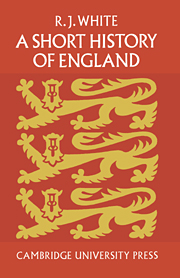Book contents
- Frontmatter
- Preface
- Contents
- Introduction: On the Character of English History
- 1 Roman Britain
- 2 Saxon England
- 3 The Anglo-Norman State
- 4 Common Law and Charter
- 5 The High Middle Ages
- 6 The Nation-State
- 7 The first Elizabethan Age
- 8 The Civil War
- 9 The Withdrawing Roar
- 10 The Century of Success
- 11 The first British Empire
- 12 The Age of Everything
- 13 War and Peace
- 14 Victorian Ages
- 15 Imperial and Edwardian
- Postscript
- Further Reading
- Index
5 - The High Middle Ages
Published online by Cambridge University Press: 14 November 2009
- Frontmatter
- Preface
- Contents
- Introduction: On the Character of English History
- 1 Roman Britain
- 2 Saxon England
- 3 The Anglo-Norman State
- 4 Common Law and Charter
- 5 The High Middle Ages
- 6 The Nation-State
- 7 The first Elizabethan Age
- 8 The Civil War
- 9 The Withdrawing Roar
- 10 The Century of Success
- 11 The first British Empire
- 12 The Age of Everything
- 13 War and Peace
- 14 Victorian Ages
- 15 Imperial and Edwardian
- Postscript
- Further Reading
- Index
Summary
When King John died at his castle of Newark on 18 October 1215, half England was in the hands of the King of France and his allies of the English baronage. John's elder son was a child of nine, and for the first time since the Conquest England was to come under a regency. Yet the minority of Henry III was not to prove a return to the anarchy of King Stephen's reign. Barons and prelates at once sounded the keynote of the new reign by assuming responsibility for the ‘state’ of the Crown until the King came of age, which meant primarily the maintenance of his estates, the material basis of his regality. On a number of occasions during a reign of more than fifty years, Henry's vassals were to declare their responsibility for maintaining the state of the Crown, even against the will of the King. It was a responsibility that the House of Commons was to assume, 400 years later, when it sought to take over command of the armed forces from Charles I by the Militia Ordinance of 1642, declaring it to be their duty to take such measures as were requisite to the security of the realm ‘although His Majesty, seduced by evil counsel, do in his own person oppose or interrupt the same’.
- Type
- Chapter
- Information
- A Short History of England , pp. 80 - 101Publisher: Cambridge University PressPrint publication year: 1967



